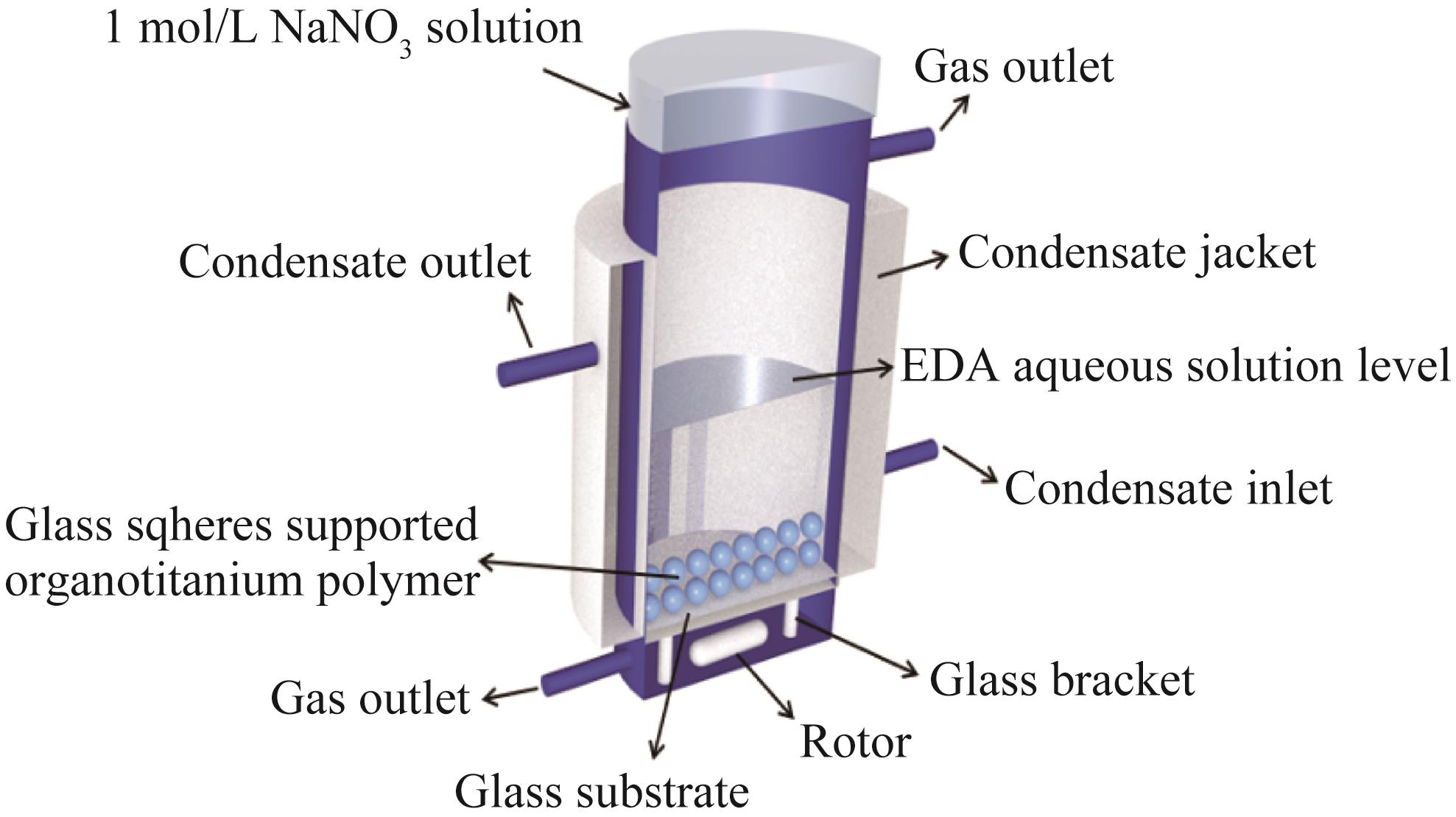
Chinese Journal of Applied Chemistry ›› 2022, Vol. 39 ›› Issue (10): 1554-1563.DOI: 10.19894/j.issn.1000-0518.210550
• Full Papers • Previous Articles Next Articles
Glass Sphere Supported Amorphous Organotitanium Polymer to Improve the Turnover Frequency in Photocatalytic Reduction of CO2
Xiang-Zhi YE1, Yun-Shui DENG1, Yuan LIU1, Yong-Liu ZHOU1, Jian-Xiong HE2, Chun-Rong XIONG1( )
)
- 1.Skate Key Laboratory of Marine Resource Utilization in South China Sea,Special Glass Key Laboratory of Hainan Province,Hainan University,Haikou 570228,China
2.Hainan Special Glass Technology Co. ,Ltd. ,Chengmai 571900,China
-
Received:2021-11-29Accepted:2022-02-23Published:2022-10-01Online:2022-10-05 -
Contact:Chun-Rong XIONG -
About author:bearcr@hainanu.edu.cn
-
Supported by:the Natural Science Foundation of China(ZDF2020015);the Construction of Scientific Research Platform of Hainan University(ZY2019HN09)
CLC Number:
Cite this article
Xiang-Zhi YE, Yun-Shui DENG, Yuan LIU, Yong-Liu ZHOU, Jian-Xiong HE, Chun-Rong XIONG. Glass Sphere Supported Amorphous Organotitanium Polymer to Improve the Turnover Frequency in Photocatalytic Reduction of CO2[J]. Chinese Journal of Applied Chemistry, 2022, 39(10): 1554-1563.
share this article
Add to citation manager EndNote|Ris|BibTeX
URL: http://yyhx.ciac.jl.cn/EN/10.19894/j.issn.1000-0518.210550
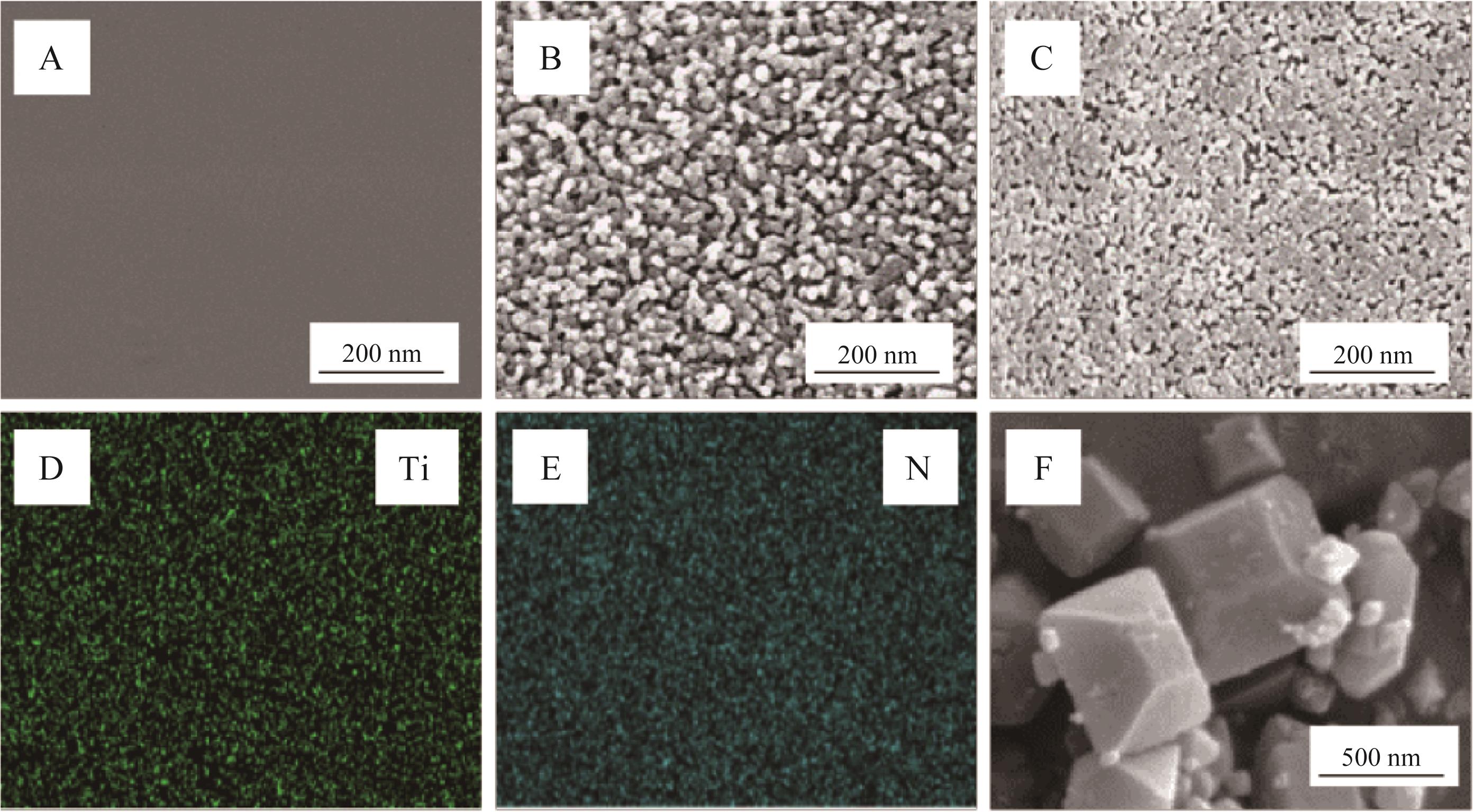
Fig.2 SEM images of the samples and the corresponding elemental mapping: (A) The surface of the glass sphere before chemical etching; (B) The surface of the glass sphere after chemical etching; (C) The surface of the glass sphere after loading with organic titanium polymer; (D) and (E) EDS elemental mapping of Ti and N; (F) NH2-MIL-125(Ti)
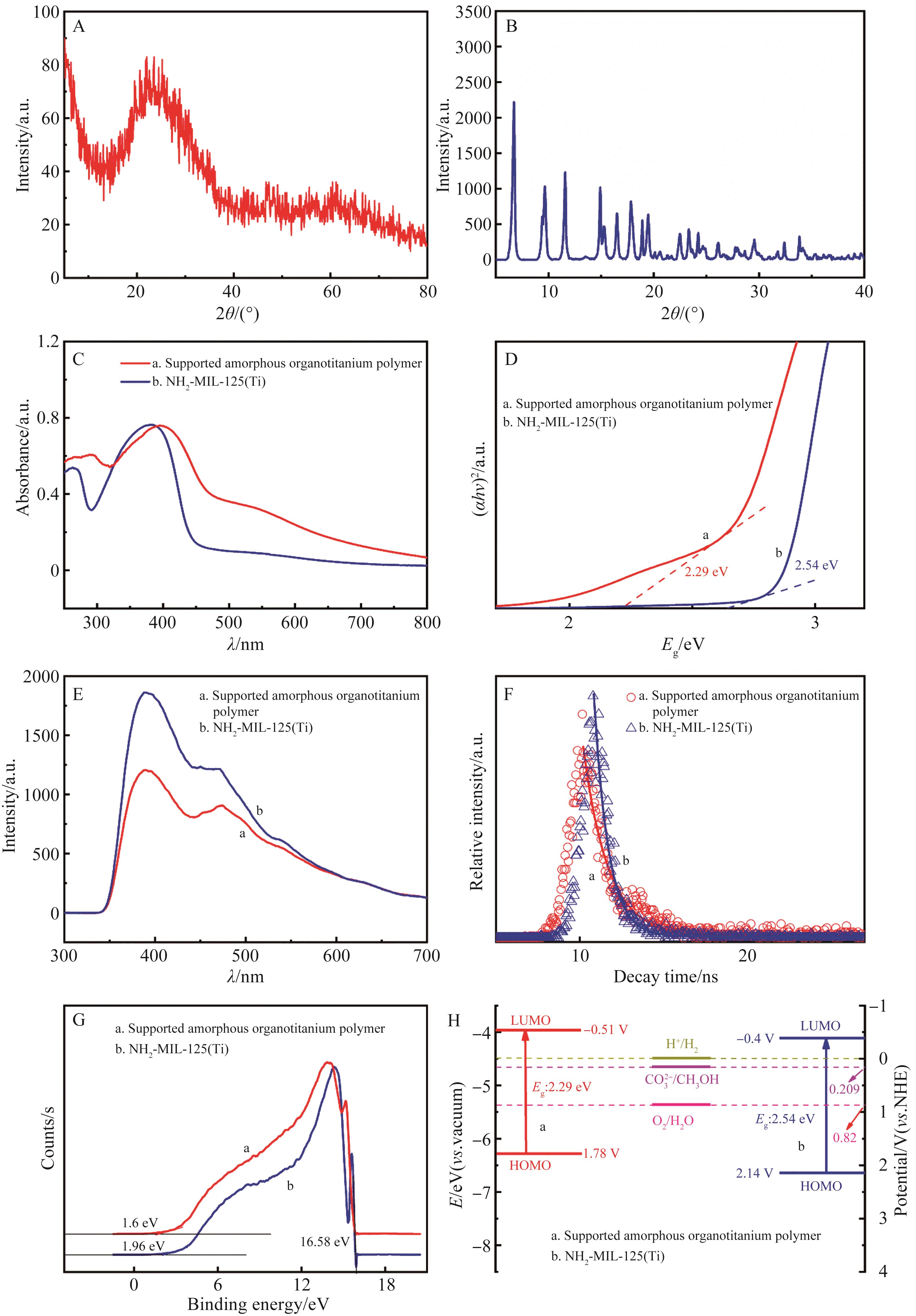
Fig.3 X-ray diffraction patterns of supported organotitanium polymer (A) and NH2-MIL-125(Ti) (B); UV-Vis diffuse reflection spectra (C) and the derived optical absorption edges (D); PL emission spectra (excitation wavelength:300 nm) (E); Fluorescence decay curves (F); UPS spectra (G) and the derived band alignment diagram (H)
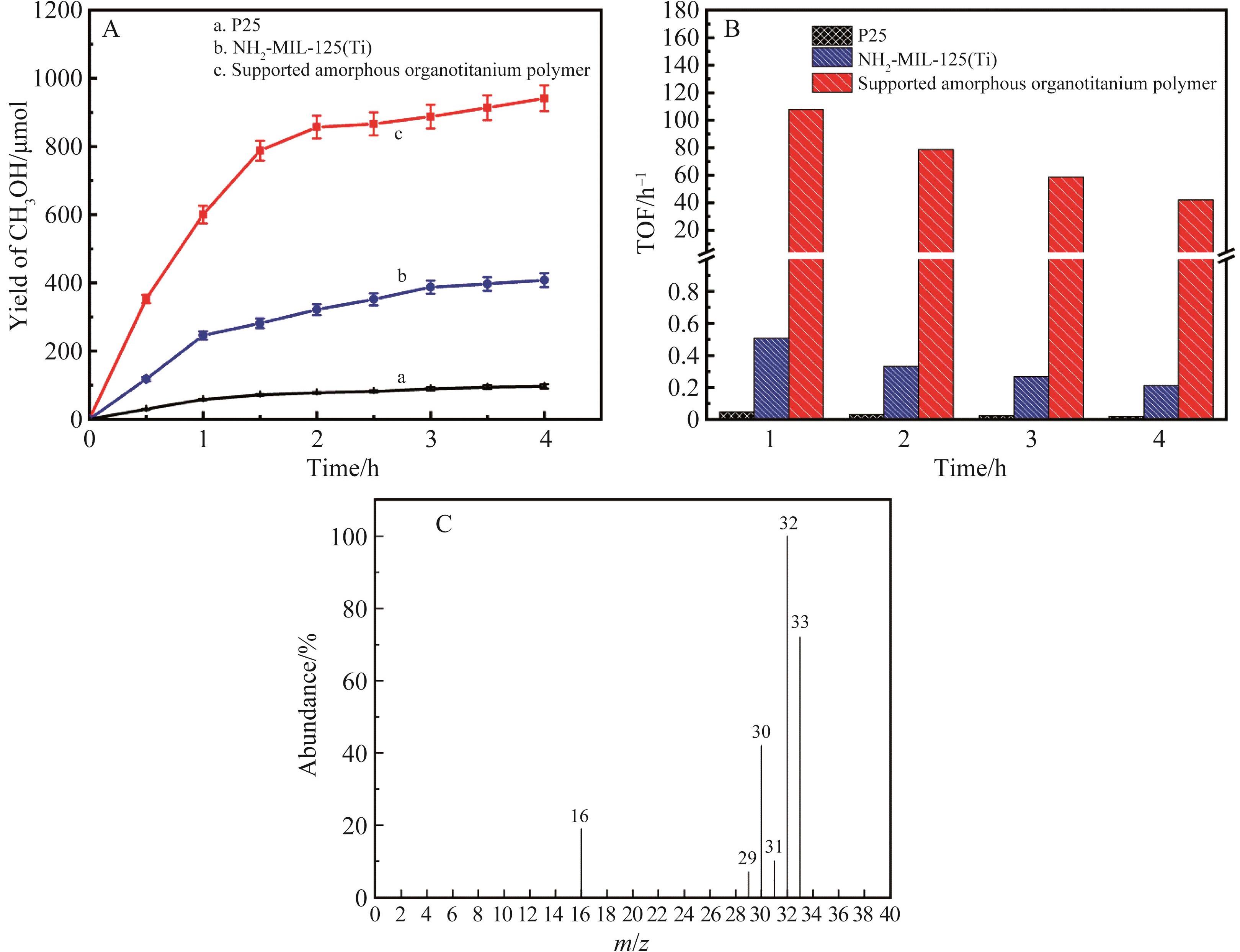
Fig.4 Photocatalytic reduction of CO2 over the supported amorphous organotitanium polymer and NH2-MIL-125(Ti) powder, respectively (A) and the corresponding turnover frequency (TOF) as function of time (B); Mass spectrum of the product in photocatalytic reduction of 13CO2 (C)
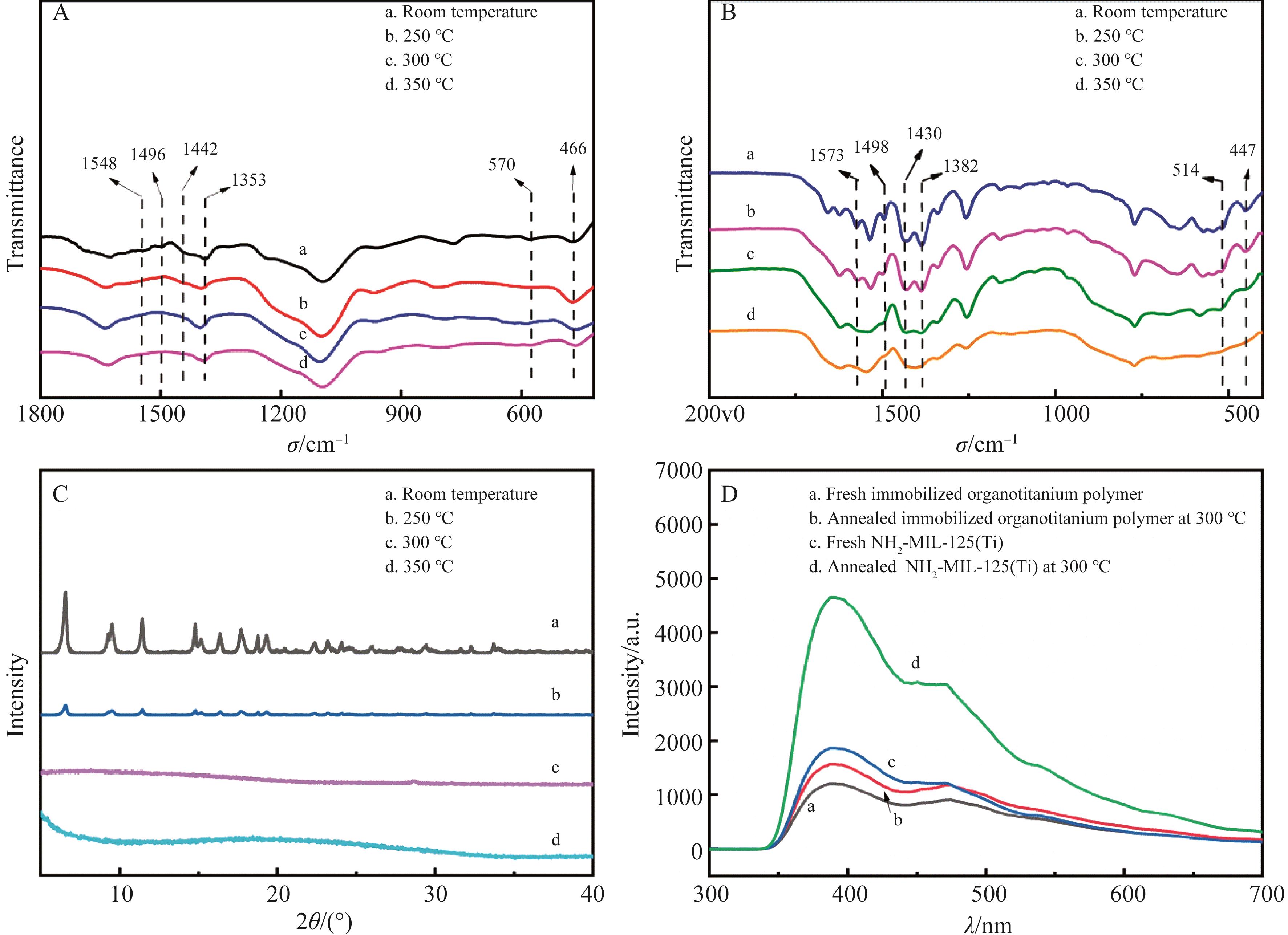
Fig.5 FT-IR spectra of the supported amorphous organotitanium polymer (A) and NH2-MIL-125(Ti) (B) upon annealing at different temperatures; XRD patterns of the NH2-MIL-125(Ti) annealed at different temperatures (C); PL emission spectra of the supported amorphous organotitanium polymer and NH2-MIL-125(Ti) before and after annealed at 300 ℃(excitation wavelength:300 nm) (D)
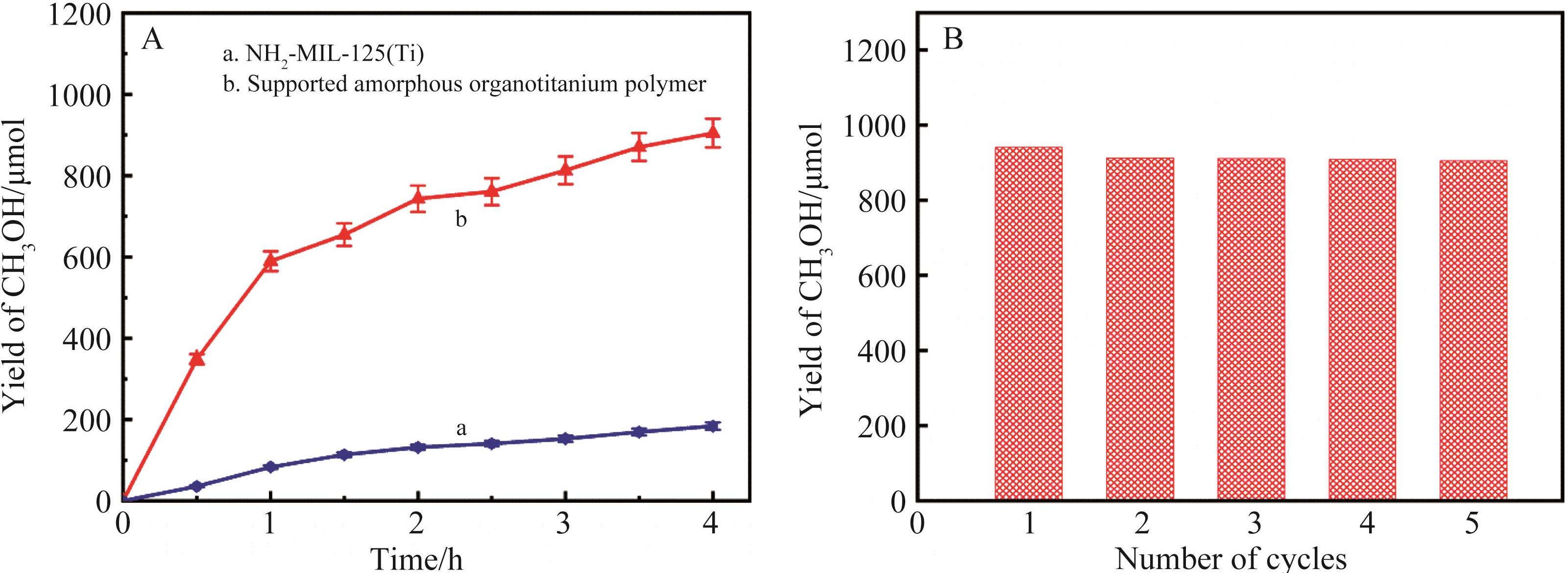
Fig.6 Photocatalytic performances over the supported amorphous organotitanium polymer and NH2-MIL-125(Ti) after annealed at 300 ℃(A); Photocatalytic performance of the supported amorphous organotitanium polymer in five consecutive cycles (B)
| 1 | DUTTA V, SHARMA S, RAIZADA P, et al. Fabrication of visible light active BiFeO3/CuS/SiO2 Z-scheme photocatalyst for efficient dye degradation[J]. Mater Lett, 2020, 270: 127693. |
| 2 | IHARA T, MIYOSHI M, IRIYAMA Y, et al. Visible-light-active titanium oxide photocatalyst realized by an oxygen-deficient structure and by nitrogen doping[J]. Appl Catal B, 2003, 42(4): 403-409. |
| 3 | KIM J, LEE C W, CHOI W, et al. Platinized WO3 as an environmental photocatalyst that generates OH radicals under visible light[J]. Environ Sci Technol, 2010, 44(17): 6849-6854. |
| 4 | 李秀芹, 李子真, 李春虎, 等. 贝壳类基纳米Fe3+-TiO2光催化降解海洋油污的动力学研究[J]. 中国海洋大学学报 (自然科学版), 2013, 43(4): 63-66. |
| LI X Q, LI Z Z,LI C H, et al. Study on the kinetic of Fe3+-TiO2/shell photocatalytic degradation of oil[J]. China Period Ocean Univ (Nat Sci Ed), 2013, 43(4): 63-66. | |
| 5 | 李桂菊, 张朕, 李弘涛, 等. 铁掺杂二氧化钛负载空微球光催化剂制备及应用[J]. 工业水处理, 2017, 37(7): 66-69. |
| LI G J, ZHANG Z, LI H T, et al. Preparation of Fe-doped TiO2-coated hollow microspheres photo-catalyst and its application[J]. Ind Water Treat, 2017, 37(7): 66-69. | |
| 6 | DU J, ZHANG J, YANG T, et al. The research on the construction and the photocatalytic performance of BiOI/NH2-MIL-125(Ti) composite[J]. Catalysts, 2020, 11(1): 24. |
| 7 | HE Y, LUO S, HU X, et al. NH2-MIL-125(Ti) encapsulated with in situ-formed carbon nanodots with up-conversion effect for improving photocatalytic NO removal and H2 evolution[J]. Chem Eng J, 2021, 420: 127643. |
| 8 | ZHANG Y, SONG J, SHAO W, et al. Au@ NH2-MIL-125(Ti) heterostructure as light-responsive oxidase-like mimic for colorimetric sensing of cysteine[J]. Micropor Mesopor Mat, 2021, 310: 110642. |
| 9 | LLABRESIXAMENA F X, CORMA A, GARCIA H, et al. Applications for metal-organic frameworks (MOFs) as quantum dot semiconductors[J]. J Phys Chem C, 2007, 111(1): 80-85. |
| 10 | WANG D, HUANG R, LIU W, et al. Fe-based MOFs for photocatalytic CO2 reduction: role of coordination unsaturated sites and dual excitation pathways[J]. ACS Catal, 2014, 4(12): 4254-4260. |
| 11 | SUN D, YE L, LI Z,et al. Visible-light-assisted aerobic photocatalytic oxidation of amines to imines over NH2-MIL-125(Ti)[J]. Appl Catal B, 2015, 164: 428-432. |
| 12 | CHUNG Y H, HAN K, LIN C Y, et al. Photocatalytic hydrogen production by photo-reforming of methanol with one-pot synthesized Pt-containing TiO2 photocatalysts[J]. Catal Today, 2020, 356: 95-100. |
| 13 | PROTTI S, ALBINI A, SERPONE N, et al. Photocatalytic generation of solar fuels from the reduction of H2O and CO2: a look at the patent literature[J]. Phys Chem Chem Phys, 2014,16(37): 19790-19827. |
| 14 | HOFFMANN M, MOSS J, BAUM M, et al. Artificial photosynthesis: semiconductor photocatalytic fixation of CO2 to afford higher organic compounds[J]. Dalton Trans, 2011, 40(19): 5151-5158. |
| 15 | HENDON C H, TIANA D, FONTECAVE M, et al. Engineering the optical response of the titanium-mil-125 metal-organic framework through ligand functionalization[J]. J Am Chem Soc, 2013,135(30): 10942-10945. |
| 16 | 赵远, 贺建雄, 姜宏, 等. 非晶态有机锆聚合物制备及其光催化CO2合成甲醇[J]. 精细化工, 2020, 37(6): 1163-1170. |
| ZHAO Y, HE J X, JIANG H, et al. Preparation of amorphous organozirconium polymer and its photocatalytic synthesis of methanol from CO2[J]. Fine Chem, 2020, 37(6): 1163-1170. | |
| 17 | FU Y, YANG H, DU R, et al. Enhanced photocatalytic CO2 reduction over Co-doped NH2-MIL-125(Ti) under visible light[J]. RSC Adv, 2017, 7(68): 42819-42825. |
| 18 | JI J, HE H, CHEN C, et al. Biomimetic hierarchical TiO2@CuO nanowire arrays-coated copper meshes with superwetting and self-cleaning properties for effcient oil/water separation[J]. ACS Sustain Chem Eng, 2018, 7(2): 2569-2577. |
| 19 | HENDON C H, TIANA D, FONTECAVE M, et al. Engineering the optical response of the titanium-MIL-125 metal-organic framework through ligand functionalization[J].J Am Chem Soc, 2013, 135(30): 10942-10945. |
| 20 | SONG W, YOSHITAKE M, et al. A work function study of ultra-thin alumina formation on NiAl(1 1 0) surface[J]. Appl Surf Sci, 2005, 251(1/2/3/4): 14-18. |
| 21 | CHEN X Y, YE X Z, HE J X, et al. Preparation of Fe3+-doped TiO2 aerogels for photocatalytic reduction of CO2 to methanol[J]. J Sol-Gel Sci Techn, 2020, 95(2): 353-359. |
| 22 | ABID H R, SHANG J, ANG H M, et al. Amino-functionalized Zr-MOF nanoparticles for adsorption of CO2 and CH4[J]. Int J Smart Nano Mat, 2013, 4(1): 72-82. |
| 23 | MOREIRA M A,SANTOS J C,FERREIRA A F,et al. Toward understanding the influence of ethylbenzene in p-xylene selectivity of the porous titanium amino terephthalate MIL-125(Ti): adsorption equilibrium and separation of xylene isomers[J]. Langmuir, 2012, 28(7): 3494-3502. |
| 24 | 邢帅, 姜宏, 熊春荣, 等. 椰壳活性炭氧化后负载硅基复合氧化物低温脱硝催化剂的研究[J]. 分子催化, 2016, 30(2): 140-150. |
| XING S,JIANG H,XIONG C R, et al. Research of silicon-based composite oxides supported on oxided cocount shell active carbon as denitration catalyst at low temperature [J]. J Mol Catal, 2016, 30(2): 140-150. | |
| 25 | QIU W, YANG Y, YANG X, et al. Preparation and characterization of metal-containing bismaleimides from divalent metal salts of p-aminobenzoic acid[J]. J Appl Polym Sci, 1997, 63(13): 1827-1831. |
| 26 | QIU W, YANG Y, YANG X, et al. Synthesis and characterization of polyimides from divalent metal salts of p-aminobenzoic acid[J]. J Appl Polym Sci, 2015, 59(9): 1437-1442. |
| 27 | HU S,LIU M,LI K,et al. Solvothermal synthesis of NH2-MIL-125(Ti) from circular plate to octahedron[J]. CrystEngComm, 2014, 16(41): 9645-9650. |
| [1] | Feng ZHU, Xiao-Lian PENG, Wen-Bin ZHANG. Research Progress in the Effects of Proton Acceptor/Donor on Electrocatalytic Reactions [J]. Chinese Journal of Applied Chemistry, 2023, 40(5): 666-680. |
| [2] | Xue-Bo LEI, Hui-Jing LIU, He-Yu DING, Guo-Dong SHEN, Run-Jun SUN. Research Progress on Photocatalysts for Degradation of Organic Pollutants in Printing and Dyeing Wastewater [J]. Chinese Journal of Applied Chemistry, 2023, 40(5): 681-696. |
| [3] | Lin-Jie SHANG, Jiang LIU, Ya-Qian LAN. Covalent Organic Framework Materials for Photo/ Electrocatalytic Carbon Dioxide Reduction [J]. Chinese Journal of Applied Chemistry, 2022, 39(4): 559-584. |
| [4] | Jia-He WANG, Da-Yong LIU, Wei LIU, Lin WANG, Biao DONG. Research Progress on Photocatalytic Antibacterial Application of TiO2 Nano Materials [J]. Chinese Journal of Applied Chemistry, 2022, 39(4): 629-646. |
| [5] | Hui LU, Jiang LI, Li-Hua WANG, Ying ZHU, Jing CHEN. Researsh Progress of Photocatalytic Applications of Atomically Precise Coinage Metal Nanoclusters [J]. Chinese Journal of Applied Chemistry, 2022, 39(11): 1652-1664. |
| [6] | Ying-Zi LI, Ting LIU, Si-Qi WU, Xuan FANG, Jing GAO, Shi TANG. Metallaphotoredox⁃Catalyzed O⁃Arylation of Serine [J]. Chinese Journal of Applied Chemistry, 2022, 39(10): 1610-1616. |
| [7] | YANG Yu-Ping, XU Shao-Hong, MA Guo-Yang, JIAO Li-Ming, SUN Li-Ping, XIA Ran. Synthesis of 5-Deuterated Ribavirin Derivative [J]. Chinese Journal of Applied Chemistry, 2021, 38(8): 911-916. |
| [8] | ZHANG Bao-Hua, SHI Lan-Xiang, GUO Rui-Xia. Synthesis and Oxidation Activity of Adamantane Supported Hypervalent Iodine Reagent [J]. Chinese Journal of Applied Chemistry, 2021, 38(6): 0-0. |
| [9] | ZHANG Bao-Hua, SHI Lan-Xiang, GUO Rui-Xia. Synthesis and Oxidation Activity of Adamantane Supported Hypervalent Iodine Reagent [J]. Chinese Journal of Applied Chemistry, 2021, 38(6): 651-657. |
| [10] | REN Li-Lei, XIAO Li-Wei, LIU Guang-Xian, XU Ming-Ming. Synthesis of Cyclopenta[d]pyrimidinones and Hexahydroquinazolinones Catalyzed by Activated Carbon Supported Sulfuric Acid [J]. Chinese Journal of Applied Chemistry, 2021, 38(1): 44-50. |
| [11] | TANG Fei, DU Duo-Qin, TAN Yun-Fei, QIN Li-Xiao. Preparation and Characterization of MoO3-x Hexagonal Microrods as High-Efficiency Photocatalysts [J]. Chinese Journal of Applied Chemistry, 2021, 38(1): 92-98. |
| [12] | ZHANG Chun-Hua, ZHAO Xiao-Bo, LI Yue-Jun, SUN Da-Wei. Preparation of (BiO)2CO3-Bi-TiO2 Composite Nanofibers and Its Photocatalytic Degradation of Antibiotics [J]. Chinese Journal of Applied Chemistry, 2021, 38(1): 99-106. |
| [13] | HUANG Jieying, LIU Jianjun, ZUO Shengli, HAN Wenjing, YU Yingchun. Preparation of Ag3PO4 Quantum Dots/g-C3N4 Nanosheet Composite Photocatalysts and Its Activity for Selective Oxidation of Benzyl Alcohol [J]. Chinese Journal of Applied Chemistry, 2020, 37(9): 1030-1037. |
| [14] | WANG Yuting,YANG Tianyi,ZHANG Yinghui. Application of Porphyrin-Based Framework Materials on Photocatalysis [J]. Chinese Journal of Applied Chemistry, 2020, 37(6): 611-619. |
| [15] | FAN Zhe,ZHANG Shengsheng,TANG Jiahao,FAN Ping. Structure, Preparation and Application of Graded Nanomaterials [J]. Chinese Journal of Applied Chemistry, 2020, 37(5): 489-501. |
| Viewed | ||||||
|
Full text |
|
|||||
|
Abstract |
|
|||||
